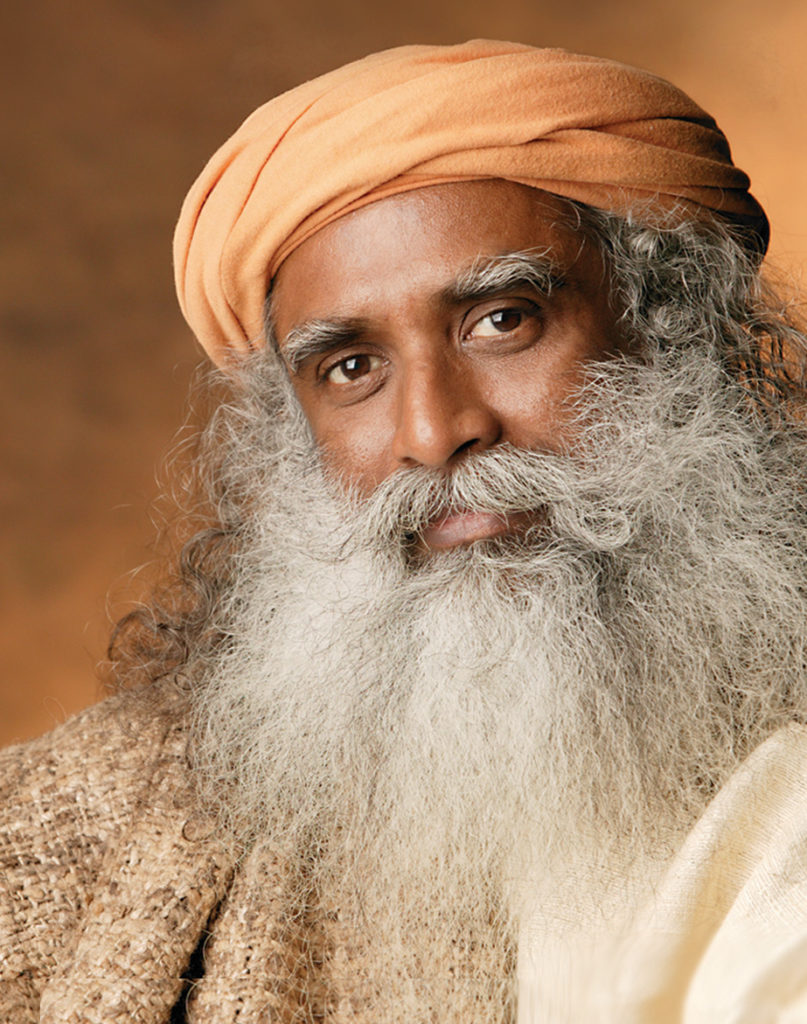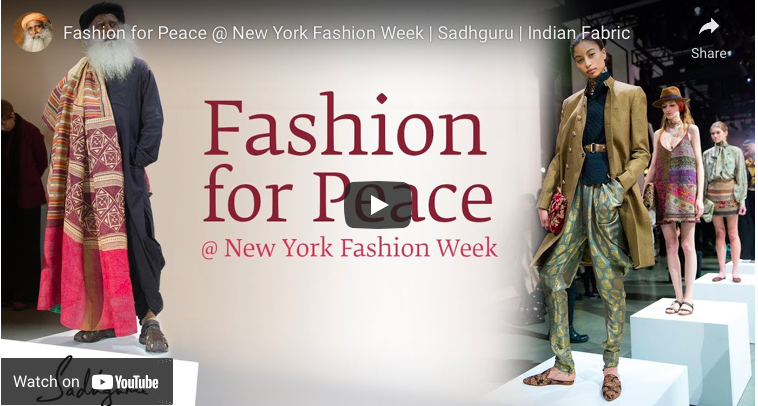
‘Fashion for Peace‘ is a collaboration between Isha Sadhguru, an Indian yoga guru, and a range of cutting-edge fashion designers from different parts of the world.[1] Presented at the New York Fashion Week of 2019, the collection proved incredibly innovative and inspiring, as it embodied Sadhguru’s ideas for ‘conscious and sustainable fashion’ and touched on connections between fashion and spirituality. Designed to convey messages beyond the aesthetic pleasures of style and substance, the show addressed the fashion industry and its consumers directly, setting an example for future practice and raising awareness of the environmental consequences of non-organic textiles.
‘On February 13, Fashion for Peace, organized by yogi mystic Sadhguru and his Isha Foundation, showcased the work of Norma Kamali, Sabyasachi Mukherjee, Mara Hoffman, and Mimi Prober, with their use of organic fibers… Sadhguru opened the event with a powerful chant, then shared sobering facts about the industry.
“If we go business as usual, by 2025 it is said that 98% of the fiber on the planet will be synthetic, of which 95% will be polyfiber. When we talk about plastics, everybody is shooting at the lowly plastic bag, which is visible, but the real plastic problem is in the microfiber which comes out of fabric, which has gotten into our soil, which has gotten into our water systems, into our food chain, and is living in our bodies. It has become part of our human system now... American is important because, for whatever reasons America has acquired a leadership in the world. If you wear blue colored trousers, half the world is wearing blue colored trousers. If you tear it up, half the world is tearing it up. So when you have such a leadership, if you go for natural fiber, the whole world will go for natural fiber. That’s why we are here.”
“Sadhguru on Fashion Sustainability: ‘the Real Plastic Problem Is in the Microfiber Which Comes out of Fabric.’” Vogue Arabia, 27 Feb. 2019
Sadhguru is the founder of Isha Foundation, which provides yoga classes to help individuals achieve inner peace, which in turn helps them foster and advocate for peace on a more global scale. It is interesting how Sadhguru’s approach to building global peace person by person, individual by individual, has come through in the designs of this fashion show. There is a cultural specificity in the colour palettes and asymmetrical designs that is rarely seen in New York fashion shows, and it is a conscious choice of the team of designers behind the show. Their attention to the traditional crafts of their respective cultural backgrounds creates a sense of inclusion in the show’s messaging, asserting that question of sustainability has to be tackled by a great variety of voices, from all corners of the world:
‘Each fabric selected for this event has been carefully curated for its uniqueness of weave, low carbon footprint and environmental sustainability. Sourced from master craftspeople and small farmers across the weaving traditions of India, these exquisite textiles reveal the remarkable depth of talent of the traditional weavers whose numbers are declining every year and whose craft is becoming rare and endangered.’
‘Fashion for Peace’, Isha Sadhguru: https://isha.sadhguru.org/us/en/events/special-events/fashion-for-peace.
The defining trait that these clothes share is their use of organic fibre, in lieu of the infinitely less environmentally-conscious, yet much more widely used synthetic fibre.[2] The setting of this show in New York is instrumental, as Sadhguru sees the American fashion market as the main catalyst of fashion trends worldwide.
Unfortunately, I fear that this fashion show has not reached the critical acclaim and media attention it deserved, with very few articles exploring the interesting world behind this fashion show, one that looks at inner peace and environmental sustainability as two interconnected worlds. However, I have chosen to include this because it is an intellectually stimulating, provocative way of examining fashion as activism – or even artivism. Via this show, fashion plays a paramount role in raising public awareness and prompting introspection, both of individual choices and global trends. It prompts both personal and political reflection on the consumerist habits of our everyday lives, and also shows that anyone can take part in creating a more peaceful world, with peace being visualised as sustainability. Sadhguru’s ‘Fashion for Peace’ asks us to pay attention to what textiles we choose to buy and wear, and therefore to what kind of supply-and-demand market we are encouraging, what kinds of people and corporations we are supporting, and what we are doing to the planet as well as its people.
What do you think?
- How interrelated do you think peace and sustainability are?
- How might paying more attention to the fabrics we wear and the consumerist choices we make contribute to peace-building around the world?
- How important is decolonisation (e.g. through the promotion of cultural diversity, the challenging of ‘western’ brands’ dominance, the inclusion of diverse voices) in promoting both peace and sustainability?
- How powerful a tool can fashion be in advocating for sustainability, social justice and diversity of voices and in promoting peace?
If you enjoyed this item in our museum…
You might also enjoy ‘Jean Gritsfeldt, Berlin Fashion Week‘, ‘Om Shanti‘, ‘Green Mosul‘ and other items with the tag ‘Fashion‘.
Federica Consiglio, May 2022
[1] To see some of the pieces in the fashion show, follow up this link: Sadhguru On Fashion Sustainability | Vogue Arabia. To learn more about Sadhguru’s ethical approach to fashion, I recommend this interview: Why Fashion for Peace: Imran Amed Interviews Sadhguru and GFX’s Patrick Duffy Interviews Sadhguru on Sustainable Fashion.
[2] To learn more about the environmental consequences of synthetic fibers, I suggest reading: Hartline, N.L., Bruce, N.J., Karba S.N., Ruff, E.O., Sonar, S.U., and Holden, P.A. (2016) Microfiber Masses Recovered from Conventional Machine Washing of New or Aged Garments, Environmental Science & Technology, Vol. 50, No.21, pp.11532-11538.
